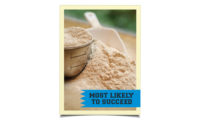
The first step is to determine the type of frozen dessert that will be developed, i.e., ice cream, sherbet, sorbet, novelties or frozen yogurt. Of course, the expected fat content of the mix, demographic targets, cost targets and any production constraints should be considered up front. If you intend to make any claims such as no-sugar-added or all-natural, it is important to determine them before proceeding. After choosing the type of frozen dessert you will produce, the next step is to define your target flavor profile and to determine what the product should look like. Contrasting colors (light and dark) are visually appealing to the eye; whereas monotone colors are not as appealing. Working with a color target can substantially speed development. With all of this information settled, you are now ready to choose the best ingredients available.
- Bases are a concentrated source of flavor and are generally used at 10% by volume of mix but can be used anywhere from 5% to 15%. You need to be cautious if you are using the base at a higher percent, as the freezing point can be affected. Regarding the Brix of an ingredient, don't choose a base that is lower in Brix than the mix, as this creates an environment that can result in an icy product. If you are using a dairy-based mix, a base with a pH below 3.0 can cause the mix to coagulate and therefore thicken in the vat. After reviewing the physical characteristics of the base, evaluate the base for flavor and color in the mix that you are planning to use. Since bases are concentrated, suppliers may not be able to add enough acid to fruit-flavored bases because it could hydrolyze their stabilizing system, thus you may need to add acid to your mix to bring out the fruit flavor.
- Variegates are another avenue to introduce flavor and texture. Variegates are generally used at 10% to 15% by volume of mix. Physical characteristics such as Brix, pH and viscosity should be evaluated. If Brix are too low, the variegate will freeze with an icy texture and if too high, the variegate will not freeze. Sweet-type variegates such as caramels and chocolates are formulated to have a Brix range of 68 to 73. This is because they have a high pH and their water activity needs to be controlled. Viscosity is the most important characteristic of a variegate to evaluate. If viscosity is too thin, the variegate could get blended or smeared into the frozen dessert. If it's too thick, the product will be too difficult to use. Suppliers can alter the variegate's stabilization system to give the customer the desired texture. Once the variegate has been chosen, it should be tasted with the flavored mix to check for compatibility.
-
Fruit feeders are designed more for show than flavor. They also add texture to frozen desserts. Depending on the desired fruit show, you can choose various shapes and sizes of fruit such as whole, sliced, diced and ground. If the desired effect is to have a lot of fruit pieces, smaller pieces should be chosen, as larger pieces give the visual effect of less fruit in the frozen dessert. Just like bases and variegates, a low Brix fruit feeder results in an undesirable icy eating experience. Again, once the desired fruit feeder has been chosen, it should be tasted with the flavored mix and/or variegates.
Once ingredients are selected and evaluated for compatibility in the flavored mix, you are ready to put it all together and make a delicious frozen dessert.
This Ingredient Technology Focus article was written by Clara Glaza, frozen dessert category lead, Degussa Fruit Systems, a product line of Degussa Food Ingredients, which specializes in development and production of fruited and non-fruited sweet ingredients. For more information call 800/280-9387, or visit www.degussa-foodingredients.com.


